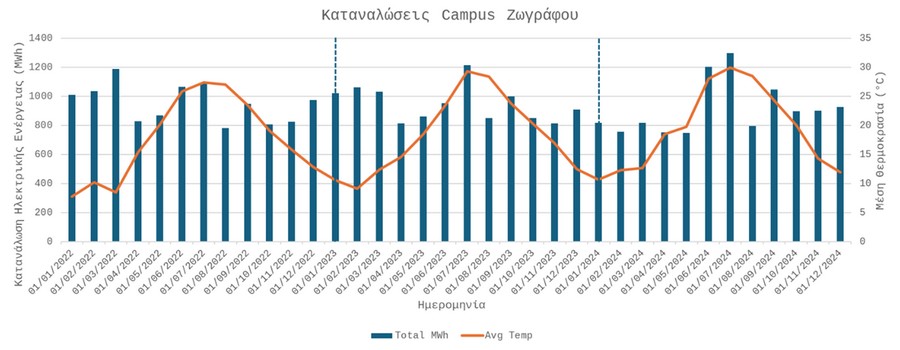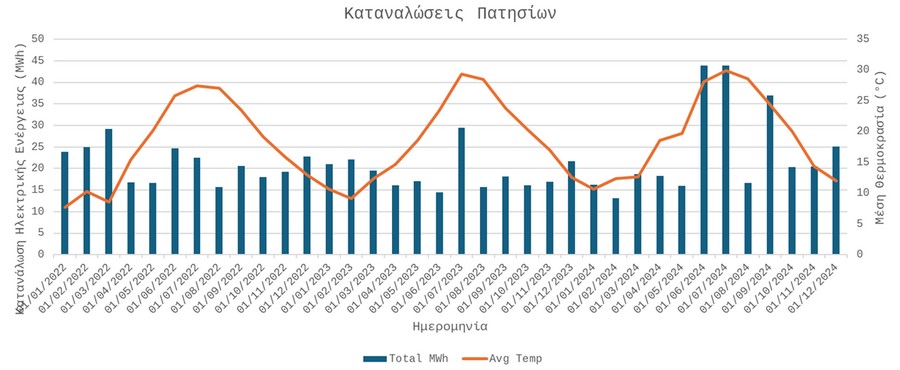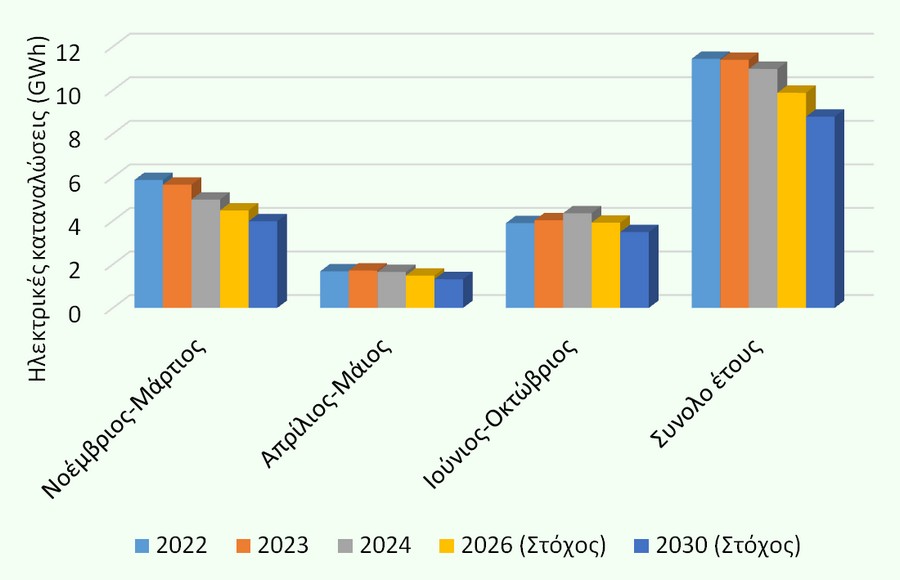Evaluation
Energy consumption and CO2 emission monitoring systems
‘The recording of electricity consumption in the buildings of the Zografou Polytechnic has started since 2015 with the installation of meters and controllers in all the faculties based at the Zografou Campus. Since 2021, meters have been installed in all three buildings on the Patission Campus, namely the Averoff building, the Tositsa building and the Bouboulina building. Below are the electricity consumption of the last three years for the two campuses in combination with the average values of the ambient temperature during these years.


Fig 22. Electricity consumption (a) for the Zografou Campus and (b) the Patission Campus
Campus Zografou
Electricity consumption for the winter months of November, December, January, February and March per year shows a continuous decrease from 2022 to 2024, confirming the effectiveness of the energy policies implemented (Fig. 23).
However, electricity consumption for the summer months of June, July, August, September and October demonstrate a slight increase, showing the need for additional energy improvement decisions. This increase may be related to reduced efficiency of air conditioning units due to age but also due to higher temperature extremes during the summer months (Fig. 23).
On the contrary, the electricity consumed for the intermediate months of April and May shows a slight decrease from 2022 to 2024 (Fig. 23).
In total, from 2022 to 2024, energy savings of 466 MWh are observed, which translates into 4%. Therefore, the replacement of energy-intensive lighting fixtures with LED lighting fixtures in the Administration building, in buildings of the Schools of Mechanical Engineering, Naval and Mechanical Engineering, has translated into satisfactory energy savings.
Campus Patission
Accordingly, an analysis of the electricity consumed from 2022 to 2024 is carried out at the Patission Campus. There is a decrease in energy consumption from 2022 to 2023, however, an increase is observed in 2024. This is due to the doubling of the electricity consumed during the summer months due to the increase in ambient temperatures and the reduced efficiency of air conditioning units.
Summary and savings goals
Fig. 23 presents the overall depiction of consumption for the three years of which the recordings were presented (2022-2024). As can be seen, Zografou campus has by far the largest participation in the institution’s annual consumption, with the Patission campus contributing only 2.6% of annual electricity consumption for the year 2024.

Fig. 23 Total annual electricity consumption of NTUAs
In the context of the green transition of the National Technical University of Athens, special emphasis is given, as already presented in the previous sections, to the energy upgrade of the NTUA facilities to reduce electricity consumption. To this end, the targeted interventions for the upgrade of the NTUA facilities aim to further reduce the total annual consumption by at least 10% by 2026 -with a reference year of 2024-. In addition, a medium-term target for 2030 has been set to further reduce total annual consumption by at least 20% again using 2024 as the reference year. Due to the significantly greater contribution of the Zografou campus to the annual total consumption of the National Technical University of Athens, special effort will be given to the reduction of consumption in the energy-intensive periods of November-March and June-October, as shown in Fig. 24, periods during which there is also a significant participation in consumption by local heating and cooling systems, respectively
.

Fig. 24 Total annual electricity consumption of Zografou Polytechnic University



